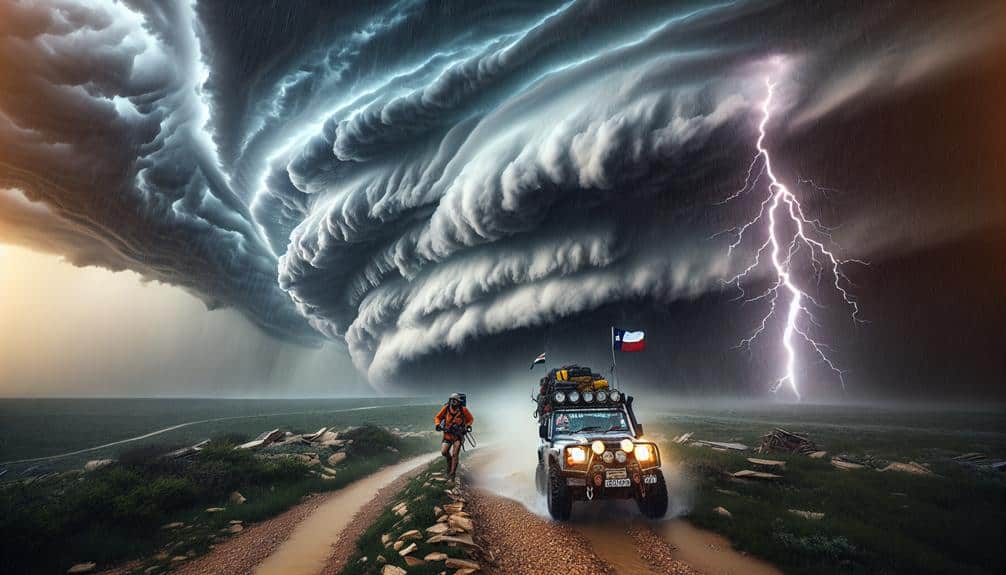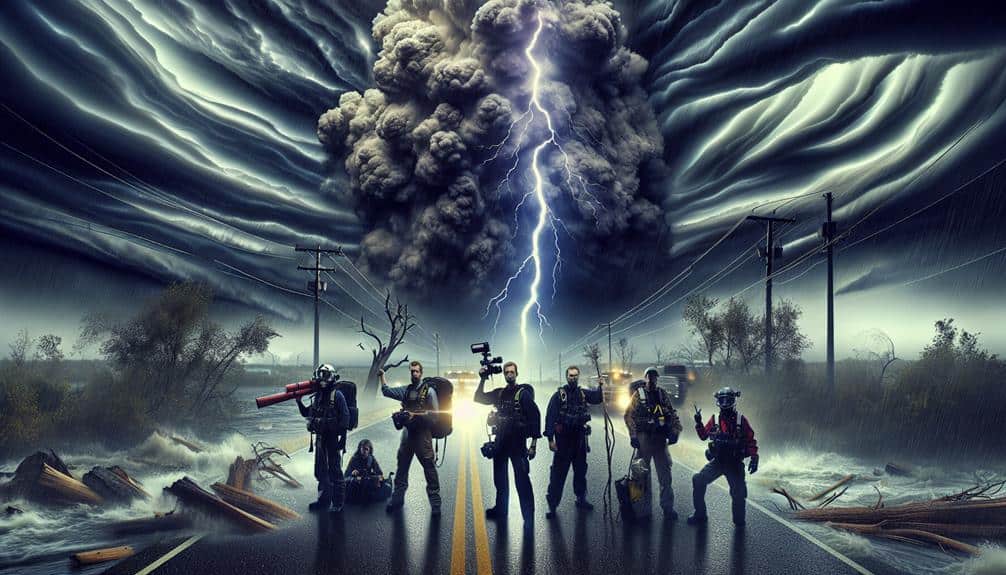As climate change strengthens, we're experiencing more frequent, intense storms, challenging storm chasers to adapt continuously. Our missions now require advanced forecasting, real-time data collection, and cutting-edge technology like drones and specialized vehicles. We've seen increased tornado activity in the Midwest, intensified hurricanes along coasts, and longer storm seasons demanding extended readiness. Thorough safety protocols and community engagement are essential to minimize disruption and ensure well-being. Infrastructure resilience and effective evacuation plans have become crucial. Tracking these evolving storm patterns enhances our preparedness and response, revealing important insights for future strategies. Keep exploring to uncover the full scope of our adaptive measures.
Key Points
- Enhanced real-time data collection and advanced forecasting models are crucial for accurate storm prediction and improved preparedness.
- Increased storm frequency and intensity require robust evaluation and adaptation of disaster preparedness strategies to ensure safety.
- Prolonged storm seasons necessitate continuous readiness and strengthened infrastructure to mitigate extended weather impacts.
- Shifts in storm zones highlight the importance of vulnerability assessments and tailored response strategies for newly affected areas.
Increased Storm Frequency
We've observed a notable increase in storm frequency over recent years, likely linked to the changing climate. This trend necessitates a robust evaluation of our current strategies in disaster preparedness. With more frequent storms, communities must enhance emergency protocols to guarantee safety and minimize disruption.
Effective evacuation plans are vital. These plans should be clear, well-communicated, and regularly practiced to ensure that residents can act swiftly when a storm approaches. Community resilience is strengthened when everyone knows their role and the quickest routes to safety.
Emergency shelters must be well-equipped and easily accessible. They provide a refuge for those displaced by storms, yet their effectiveness hinges on proper location, capacity, and resources. By investing in sturdy, well-maintained shelters, communities can offer immediate protection when it's most needed.
Disaster preparedness extends beyond physical infrastructure. Education campaigns and regular drills help instill a proactive mindset. When individuals understand the risks and know how to respond, collective resilience is greatly enhanced.
Greater Storm Intensity
As we examine greater storm intensity, we need to contemplate rising wind speeds, increased rainfall amounts, and enhanced tornado activity.
Scientific data shows that these factors are becoming more pronounced due to climate change.
Our mission must adapt to these evolving conditions to guarantee accurate data collection and safety.
Rising Wind Speeds
Rising wind speeds, driven by climate change, are contributing to the increasing intensity of storms we now face. By examining recent data, we see a clear trend: stronger and more frequent storms. These turbulent forecasts demand that we reassess our strategies for storm preparedness.
As storm chasers, our role is pivotal in understanding these phenomena and mitigating their impacts.
One of the significant challenges we encounter is the need for improved wind resistance in infrastructure. Buildings, bridges, and other structures must be designed or retrofitted to withstand higher wind speeds. Failure to do so could result in catastrophic damage, posing severe risks to both property and lives.
Moreover, as we gather more data, we notice that conventional forecasting models often struggle to predict the behavior of these intensified storms accurately. The chaotic nature of rising wind speeds introduces greater uncertainty, complicating our efforts to provide timely and precise warnings.
Addressing these issues requires a multifaceted approach. Enhanced building codes, advanced forecasting technologies, and continuous data collection are essential steps.
Increased Rainfall Amounts
Greater storm intensity, marked by increased rainfall amounts, demands we scrutinize the implications for flood-prone areas and water management systems. As storm chasers, we must assess how urban planning can mitigate the impact of excessive rainfall.
Cities with inadequate drainage systems face heightened flood risks, necessitating investments in advanced water management infrastructure. Enhanced stormwater systems, permeable pavements, and green roofs are essential components of urban planning to handle increased precipitation.
In rural regions, agriculture resilience is critical. Heavy rainfall can lead to soil erosion, nutrient runoff, and crop damage, threatening food security. We need to develop strategies to bolster agriculture resilience, such as improved irrigation techniques, soil conservation practices, and the cultivation of drought-resistant crops.
Additionally, ecosystem adaptation becomes indispensable. Wetlands and forests play pivotal roles in absorbing excess water and reducing flood risks. Preserving and restoring these natural buffers can enhance our overall resilience to greater storm intensity.
Enhanced Tornado Activity
Frequently, the escalation in tornado activity demands a thorough evaluation of our preparedness and response strategies. We've observed that tornadoes are becoming more intense and frequent, which means we must adapt our damage assessment and emergency response protocols accordingly.
Enhanced tornado activity brings a higher potential for destruction, necessitating swift and accurate damage assessment to prioritize resources efficiently.
Our current emergency response systems need to be robust and flexible to handle these increased demands. Real-time data collection and analysis are essential in this regard. By leveraging advanced technologies, we can improve the speed and accuracy of our response.
For example, drones and satellites can provide immediate aerial views of affected areas, allowing us to allocate emergency services where they're needed most.
Moreover, community education plays a vital role. Residents must understand the importance of having emergency plans and know how to act when warnings are issued. By promoting individual preparedness, we can reduce the burden on emergency services during critical moments.
Unpredictable Weather Patterns

Unpredictable weather patterns challenge storm chasers to adapt their strategies and tools continuously. As climate adaptation becomes essential, we find ourselves grappling with increasing weather uncertainty. This unpredictability necessitates adopting advanced forecasting models and real-time data analytics to stay ahead of rapidly changing conditions. Our ability to predict storm paths and intensities hinges on leveraging cutting-edge technology.
We've seen that traditional patterns are less reliable, compelling us to refine our approaches. By integrating machine learning algorithms and high-resolution satellite imagery, we can enhance our decision-making processes. These innovations allow us to respond more swiftly and accurately, providing vital insights that mitigate risks and optimize our missions.
Moreover, we need to re-evaluate our equipment and methodologies. Drones equipped with sophisticated sensors now play a pivotal role in gathering atmospheric data from previously inaccessible areas. This technological shift underscores the importance of flexibility and adaptability in our fieldwork.
Extended Storm Seasons
As we adapt to unpredictable weather patterns, we're also contending with extended storm seasons that demand prolonged attention and readiness. This shift requires us to rethink our approaches to community preparedness and infrastructure strength. Evidence indicates that longer storm seasons lead to more frequent and severe weather events, increasing the pressure on our disaster response systems.
We must enhance community preparedness by educating citizens on emergency planning and making certain they've access to necessary resources. Communities can establish local emergency hubs equipped with essential supplies and information. This proactive approach empowers individuals, allowing them to act swiftly and effectively during crises.
On a larger scale, infrastructure resilience becomes essential. Strengthening our buildings, roads, and utilities to withstand prolonged exposure to severe weather isn't just a preventive measure—it's a necessity. Investments in resilient infrastructure can mitigate damage, reduce recovery times, and ultimately save lives.
Moreover, effective disaster response hinges on seamless coordination between local, state, and federal agencies. By refining our emergency planning frameworks and conducting regular drills, we can make sure a rapid and efficient response when storms hit. In doing so, we safeguard our freedoms and enhance our collective strength against the evolving climate challenges.
New Geographic Storm Zones

We've observed shifting weather patterns that indicate storm zones are no longer confined to traditional areas. Emerging risk areas now require us to reassess and adapt our response strategies.
Shifting Weather Patterns
Recent data indicate that climate change is causing significant shifts in weather patterns, leading to the emergence of new geographic storm zones. As we analyze these trends, it's clear that our ecosystems are rapidly changing. For instance, areas that previously experienced mild weather are now seeing more intense storms. This shift necessitates urgent weather adaptation strategies to mitigate the impacts on both human life and the environment.
We need to understand the underlying factors driving these changes. Warmer ocean temperatures and altered jet streams are contributing to the relocation of storm zones. The increase in atmospheric moisture is another critical factor, amplifying storm intensity and frequency. These changes aren't just theoretical; they're backed by robust scientific evidence.
Emerging Risk Areas
Emerging risk areas are becoming increasingly apparent as new geographic storm zones develop due to climate change. Our vulnerability assessments reveal that regions previously considered safe are now facing heightened risks. For instance, the Midwest, historically less prone to severe storms, is experiencing an uptick in tornado activity.
Similarly, coastal areas are witnessing intensified hurricanes and rising sea levels, reshaping our understanding of high-risk zones.
The new climate reality is expanding the boundaries of storm-prone areas. It's not just about more frequent storms; it's about where these storms are striking. Data shows that the northeastern U.S. is now more susceptible to powerful hurricanes compared to past decades. This shift necessitates a re-evaluation of preparedness plans and resource allocation.
We must consider the socio-economic impacts on communities within these emerging risk areas. Vulnerability assessments indicate that low-income neighborhoods are disproportionately affected, lacking the resources to mitigate damage and recover quickly.
As storm chasers, our mission now includes not only tracking these storms but also understanding the evolving geographic risks. By doing so, we can provide more accurate warnings and support communities in adapting to this new climate landscape. This will empower individuals to protect their freedoms and livelihoods.
Adaptive Response Strategies
In addressing the challenges posed by new geographic storm zones, we must develop adaptive response strategies that are both proactive and grounded in empirical data. Accurate forecasting and real-time data collection enable us to anticipate storm patterns more effectively.
Community engagement is pivotal; by involving local populations in preparedness plans, we empower them to take informed actions.
Policy development should prioritize resilience. Drafting policies that encourage infrastructure adaptation ensures that buildings, roads, and utilities can withstand extreme weather events. For instance, updating building codes to include storm-resistant materials can mitigate damage and save lives.
Stakeholder collaboration is crucial for these initiatives. By fostering partnerships between government agencies, private sector entities, and non-profits, we can pool resources and expertise for a more robust response.
Evidence shows that communities with strong ties and clear communication channels recover faster from disasters. Therefore, fostering a culture of preparedness and mutual support is essential. Through workshops, drills, and public information campaigns, we can enhance our collective resilience.
Equipment and Technology Needs
To effectively pursue their mission, storm chasers need cutting-edge gear and technology tailored to withstand extreme weather conditions. Advanced drones and sophisticated monitoring systems enable us to gather real-time data from the eye of the storm without risking human lives unnecessarily. These drones can measure wind speeds, pressure changes, and moisture levels with a high level of accuracy, allowing us to make informed decisions quickly.
Specialized vehicles are another essential component. They're designed to navigate challenging terrain and endure the severe impacts of high winds and debris. These vehicles are often equipped with robust communication devices that guarantee we stay connected with our teams and emergency services, even when traditional communication networks fail.
The integration of these technologies enhances our ability to predict storm paths and intensities more precisely. By constantly updating our data, we can adjust our strategies in real-time, thereby increasing our operational efficiency.
As climate change intensifies the frequency and severity of storms, investing in state-of-the-art equipment and technology isn't just advantageous—it's crucial. This approach not only supports our mission but also aligns with the broader goal of safeguarding human lives and property.
Safety and Risk Management

While storm chasers face inherent dangers, implementing strict safety and risk management protocols is vital to minimize harm and maximize mission success. We must establish detailed safety protocols that include real-time weather monitoring, communication plans, and equipment checks. Evidence shows that teams adhering to these protocols greatly reduce incident rates. By integrating advanced technology, like GPS tracking and weather radar, we ensure more precise positioning and timely responses to changing conditions.
Emergency preparedness is equally important. Our training programs should cover first aid, vehicle maintenance, and evacuation procedures, preparing us for worst-case scenarios. Studies indicate that teams with strong emergency plans are better positioned to handle unexpected situations, thereby preserving both lives and equipment.
We also need to foster a culture of continuous learning. Regular debriefs and scenario-based drills enable us to adapt swiftly to new challenges. This proactive approach not only enhances our safety but also empowers us to operate with greater independence and confidence.
Ultimately, our mission's success hinges on a unwavering commitment to safety and preparedness. By prioritizing these elements, we can pursue our passion for storm chasing while safeguarding our well-being and freedom.
Frequently Asked Questions
How Do Storm Chasers Contribute to Climate Change Research?
We collect and analyze data from extreme weather events, collaborating with researchers to understand climate patterns. Our contributions have a significant impact on climate change research, driving informed decisions and fostering resilience in affected communities.
What Training Do Storm Chasers Undergo Before Heading Into the Field?
We undergo rigorous simulation exercises to handle diverse weather scenarios and learn essential safety protocols. Some might think it's excessive, but this training guarantees we can operate effectively and safely in unpredictable, hazardous environments.
Are There Specific Qualifications Required to Become a Storm Chaser?
To become a storm chaser, we need relevant education and experience. Safety is paramount, so we must be proficient with specialized equipment. Though formal qualifications aren't mandatory, meteorology or related fields greatly enhance our effectiveness and safety.
How Do Storm Chasers Fund Their Expeditions and Equipment?
We typically fund our expeditions through diverse funding sources like sponsorships, grants, and personal savings. Equipment costs vary substantially, but we prioritize high-quality gear to guarantee safety and maximize data accuracy.
What Psychological Challenges Do Storm Chasers Face During Extreme Weather Events?
Facing a tempest akin to Odysseus' trials, we develop emotional resilience but struggle with mental health. We rely on mental health support to cope with the intense stress and psychological challenges of extreme weather events.


